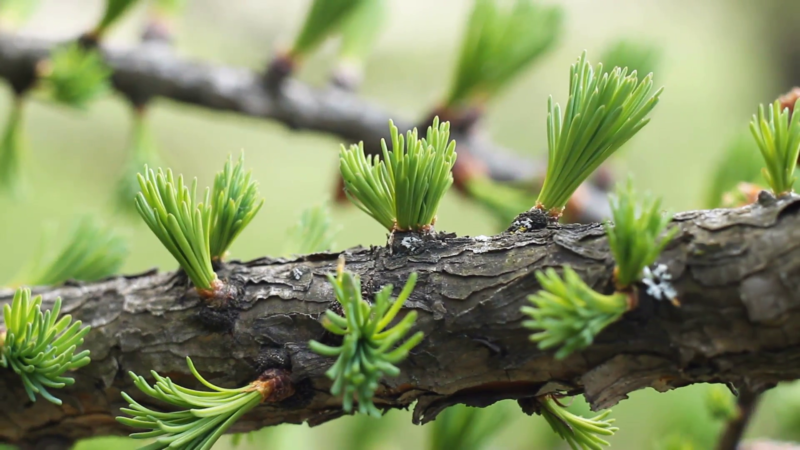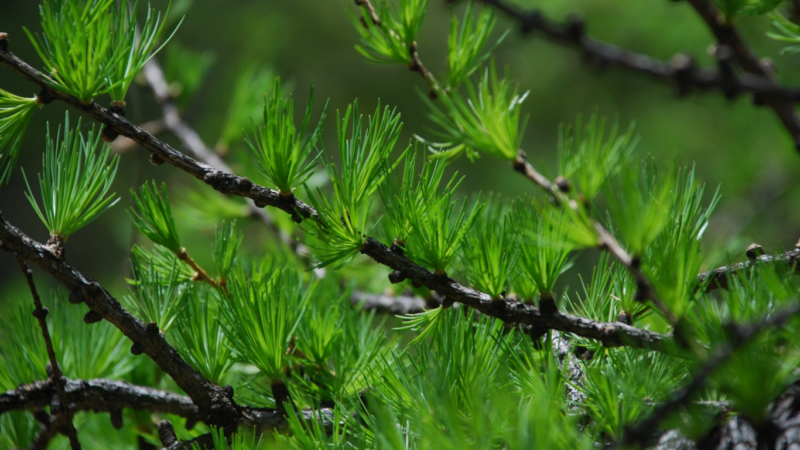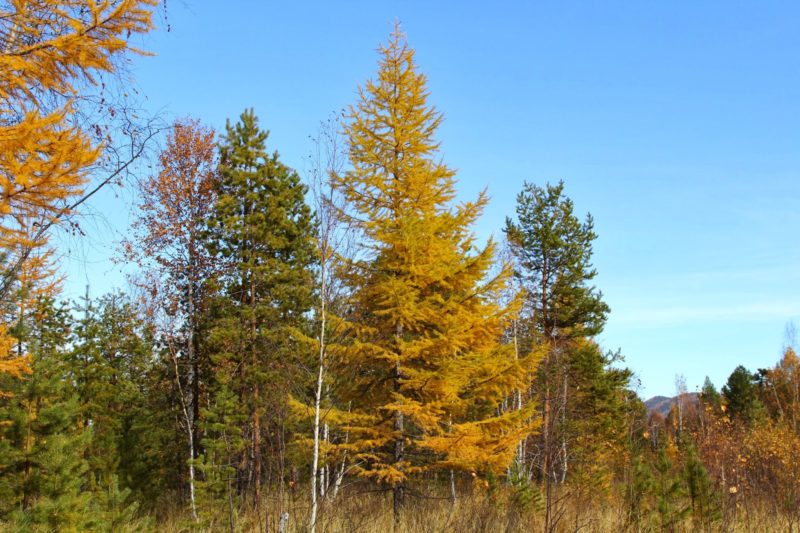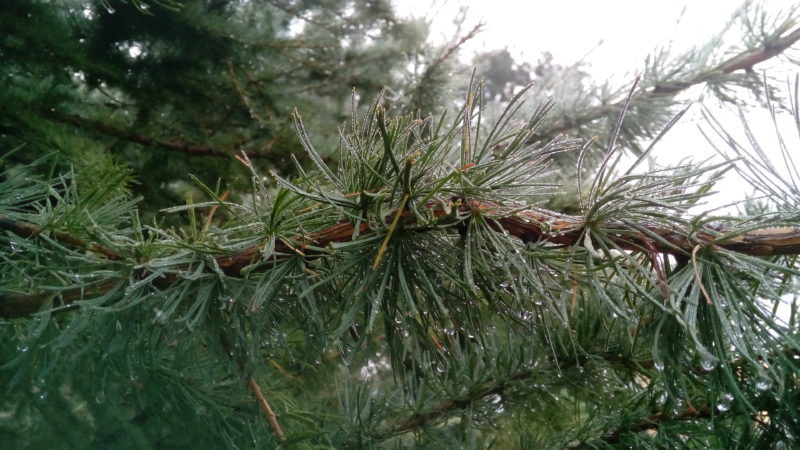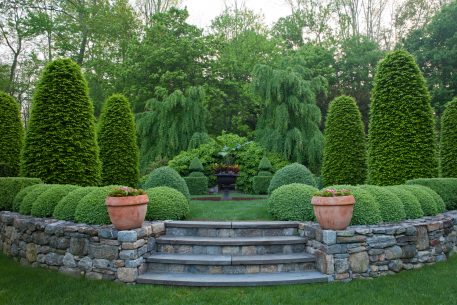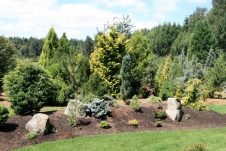Among the coniferous trees that inhabit the forest zones of Russia, there is an amazing plant - larch, which has the healing properties of bark, resin and needles and the special strength of wood. On the eve of autumn, light green soft needles acquire a saturated bright yellow color and fall off, growing again in the spring. The tree has many varieties, one of which is Siberian larch - a hardy plant that can grow on any soil. Thanks to the selection, several decorative forms were used that are used in landscape design, but retaining the properties of a wild relative.
Material Content:
Botanical description of the species of Siberian larch
An adult tree in the wild Larix Sibirica grows in height 30 - 45 m, with a straight conical trunk, the lower part of which reaches a diameter of up to 1.8 m. Young trees with a pyramidal crown, growing, form a rare round-shaped crown.
They grow rapidly for 30 - 40 years, adding up to 50 cm annually. Then growth slows down, the shape of the crown changes to rounded, the branches are perpendicular to the cone of the trunk and smoothly bend upwards - these are the hallmarks of Siberian larch among the relatives of the Sosnovy family.
- The tree has a well-developed rod root system with far-reaching lateral roots that can withstand strong winds.
- The bark of young trees is yellowish, smooth, thin, with age it becomes thick, dark brown, covered with longitudinal cracks.
- Soft needles are flat, with a blunt tip, grow up to 45 mm, light green with a bluish bloom, are located on the shoots in bunches of 30 to 40 pieces.
- Monoecious plant. It has inflorescences both male (spherical, pale yellow, with a diameter of 5 - 6 mm, with numerous anthers) and female (conical, purple or pink up to 15 mm long). Pollination occurs by the wind at the same time as the needles bloom in April - May and lasts up to 2 weeks.
- From female inflorescences, small brown or yellow oblong-oval cones are formed, growing above the shoot up to 2 to 4 cm in size with small winged seeds that ripen in the summer and disperse in the fall.
- Trees growing in close proximity begin to bear fruit in the 30th year of life. Lonely standing - in 15 - 20 years. Seed formation occurs once every 2 to 3 years, and in a harsh climate only after 6 to 7 years.
Among the Pine family, Siberian larch is a long-liver. The average age of life expectancy is 500 years. There were giants living for 1000 years.
Distribution area
The name of the plant itself speaks of the main area of Siberian larch. In the forests of Siberia, representatives of the species can be found both in mixed plantings and in their own groves. Larch forests usually make up woodlands. Thanks to the openwork crown, they transmit light well, creating a slight shadow, therefore, among the larch trees there are numerous species of shrubs and small trees.
- Siberian larch, well adapted to the harsh conditions of the north, can be found in the Tundra, in permafrost and in the upper reaches of the highlands.
- In the company of coniferous species of trees, such as spruce, pine, cedar and fir, larch extends to the Urals, capturing the European part of Russia in the river basins of Vetluga and Unzhi. It also grows in the lower reaches of the Vyatka and Kama rivers, in Transbaikalia and in Altai.
- A photophilous plant, not picky about soil types, can be found in the northern deserts of Mongolia, Kazakhstan and China.
The ability of larch needles to attract harmful substances from the air, decorative appearance and unpretentious growth allow the plant to be grown in industrial zones and city parks, on boulevards and along driveways, as well as used in landscaping of a personal plot.
Growing Features
This tree species is distinguished by endurance, durability, intensive growth. It grows well in the forest-tundra, forest-steppe, on sand and peat bogs, in limestone and granite, in river valleys and interfluves.
Only stagnant waters and prolonged drought are dangerous for the survival of larch.
For better survival of the seedling, preservation of long-term decorativeness of the tree, it is necessary to adhere to some conditions:
- The landing position should immediately be constant - the tree does not tolerate transplanting.
- The place is spacious and sunny, the distance to the nearest plantations and between the seedlings is at least 2 - 3 m.
- Optimum soil is gray forest loam with medium or low acidity, well aerated, moist or medium humid.
- Mandatory presence of mycorrhiza. Suitable mycelium of porcini mushrooms, butter, boletus.
Siberian larch is planted singly, in groups, alleys and in composition with other types of trees. This species tolerates pruning well, so that it is possible to form a plant, customizing it to the conditions of the landscape.
Outdoor landing
It is best to plant a tree at the age of 2 - 4 years. A favorable planting time is early spring, when the buds have not yet opened, or late autumn, after the needles have fallen.
- 2 times more are dug out a planting hole than an earthen lump of a seedling. Usually the dimensions are 50 by 50 cm.
- With a close occurrence of groundwater, the bottom is covered with drainage (you can use broken brick), and a third of the pit is covered with soil in which the presence of peat and lime is desirable (if the soil is acidic).
- Dip the tree in the hole so that the root neck remains on the surface, and is covered with the remaining soil.
- Pour plenty of water (10 - 15 L).
In the soil for planting, it is advisable to add forest land from under the roots of any conifer 100 - 300 g / m2. It contains mycelium of mushrooms, which will save mycorrhiza larch.
How to care for conifers
When growing a tree, you should follow some simple rules that will allow him to live a long and healthy life:
- Even adult larch does not tolerate drought, so watering is an important point in the future care of the seedling. The soil should always be slightly moist.
- From drying out the soil helps mulching. It also facilitates weeding and loosening the near-stem circle.
- If larch has taken root and has been growing safely for a couple of years, then weed control is not necessary. They do not affect the quality of life of an adult plant.
- In the driest season, watering remains mandatory. Under an adult tree, at least 2 to 3 buckets of water must be applied. Pour the water under the larch, in which you wash the mushrooms collected in the forest, this top dressing promotes the growth of beneficial microorganisms that have a beneficial effect on root growth and tree health.
- The sapling responds well to complex fertilizers. You can use tools for conifers, "Kemira wagon" or any other nutrient complex.If the larch grows well, and the appearance matches the parameters, then extra feeding is not necessary.
- Young seedlings need shelter for the winter, you can wrap it with ultrasil or spanbond. It is necessary to build a hut out of sticks so that a large amount of snow does not bend the trunk or break the shoots.
Common Diseases and Pests
Siberian larch can have many different ailments caused by agrotechnical disturbances and mechanical damage.
Among the errors in the rules of care can be identified:
- low-quality planting material;
- deepening of the root neck;
- increased soil moisture;
- plant shade by other trees;
- thickening of the landing;
- cracking of the bark, as a result of frostbite of the plant.
All these omissions create favorable conditions for infection with fungal spores, which entail the drying out and decay of the needles, the death of shoots, and possibly the death of the plant.
Among the diseases to which the tree is affected, fusarium, rust, shute, branch necrosis, step cancer and stem rot, alternariosis are distinguished.
Treatment comes down to:
- compliance with all requirements for growing Siberian larch;
- elimination of violations of care;
- pruning and burning of affected branches;
- treatment of individual wounds with disinfectant solutions (1% solution of copper sulfate);
- and glossing over wounds or sections (oil paint on a natural drying oil).
In early spring and late autumn, the development of pathogenic microflora can be prevented by preventive spraying with a 1% Bordeaux mixture, HOM solution and other similar fungicides.
Larch also has a mass of specific insect pests, eager to feast on the juice of the plant. These are larch flies, green and common sawflies, gray leaflets, cap moths, kidney gall midges, red and green hermes, greenish hermes (large aphids). As well as pests of neighboring conifers can cause significant damage to both the appearance of the larch and its health.
Preventive spraying with insecticides in May - June and during the mass summer of insects, the immediate collection of single individuals, additional treatment with the same compounds in case of mass damage will protect the plant. You can use one of the drugs: Inta-Vir, Iskra, Actellik, Fufanon, Decis Profi.
Use in landscape design
Coniferous trees in landscaping are commonly used plants. Larch is no exception.Siberian is used in park and forest zones, squares, continuous massifs of alleys, in personal plots in the form of single plantings or background compositions.
Various colors of needles from light green to gray shade and the possibility of forming a crown allow you to create ensembles from mixed plantings. It goes well with all types of conifers, as well as with birch, mountain ash and red maple. Original compositions with lilac, rhododendrons, mock-up and similar flowering shrubs look original.
Often planted this species of larch as the dominant plant in rock gardens and rockeries, and also solve the problem of high hedges.
The scattered shadow from the openwork crown of Siberian larch serves as a reliable shelter for garden flowers and fruit trees in the midday heat.



